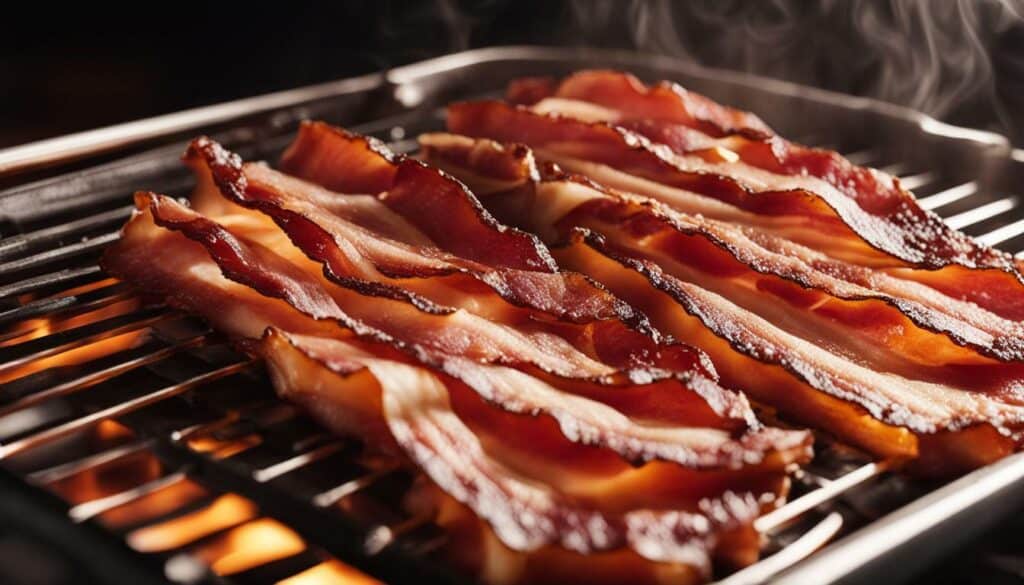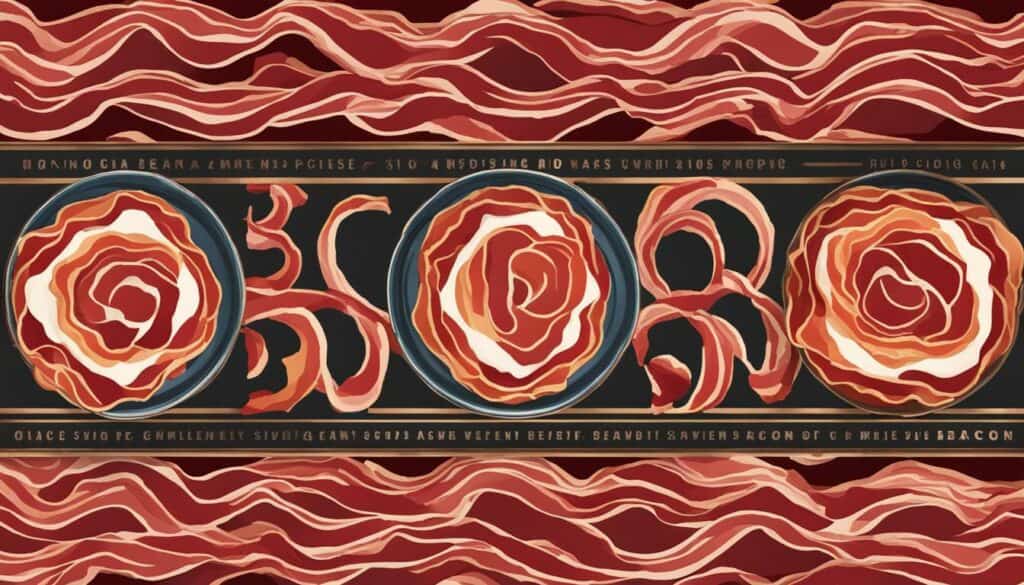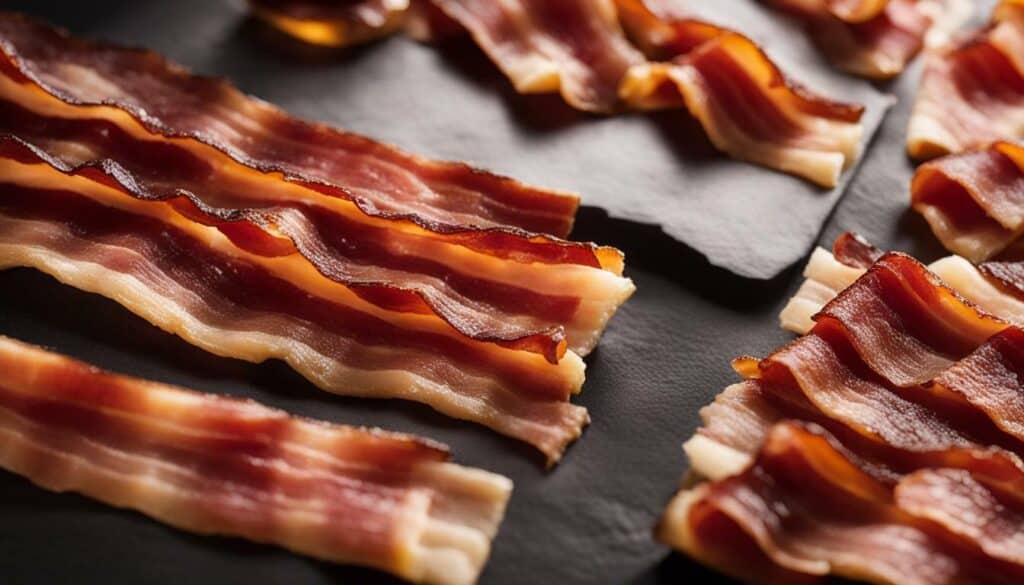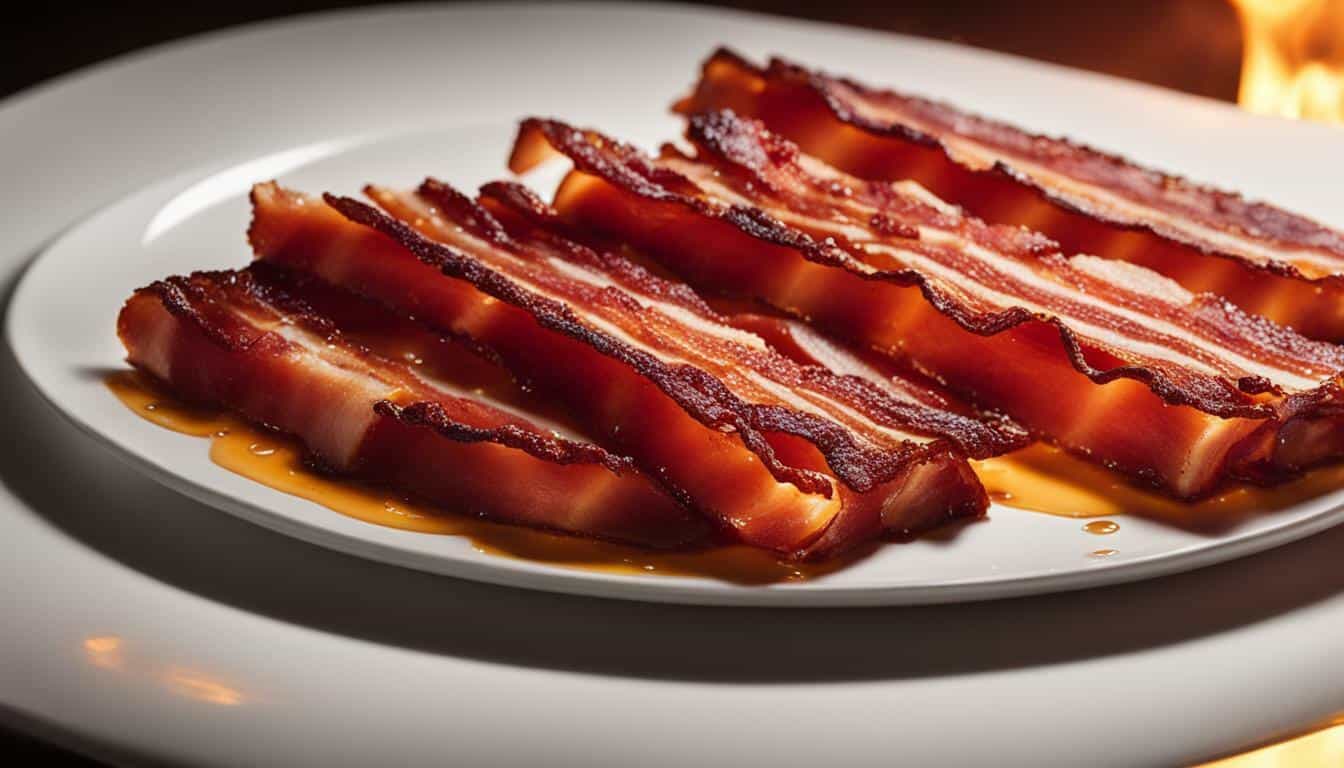Bacon lovers rejoice! In this article, we will uncover the truth about calories in 3 pieces of bacon and explore the nutrition facts and serving size to help you make informed choices for a delicious and balanced breakfast.
When it comes to everyone’s favorite breakfast indulgence, it’s important to know the nutritional value of what we’re consuming. That’s why we’re here to shed light on the calories in 3 pieces of bacon, so you can enjoy this savory treat while still maintaining a healthy lifestyle.
Key Takeaways:
- The calorie content of 3 medium slices of bacon is 130 calories.
- These slices contain 10.03g of fat, 0.34g of carbohydrates, and 8.89g of protein.
- The breakdown for these bacon slices is 71% fat, 1% carbs, and 28% protein.
- Nutritional values may vary for different brands, so it’s important to check labels for accurate information.
- MyFitnessPal is a valuable resource for tracking macros, calories, and more, providing exercise demos, workout routines, and recipes for a holistic wellness roadmap.
Now that you have the essential information about the calories in 3 pieces of bacon, you can make educated choices while savoring this beloved breakfast staple. Remember, everything is better in moderation, so enjoy your bacon responsibly!
The Basics of Bacon Nutrition
Before we dive into the specific calorie count, let’s explore the basics of bacon nutrition and understand the broader dietary implications. Bacon is a popular breakfast food enjoyed for its savory taste and crispy texture. It is primarily made from pork belly, which provides both fat and protein in varying amounts.
Bacon is known for its high fat content, which gives it its rich flavor. In fact, approximately 71% of the calories in bacon come from fat. While fat is an essential nutrient that provides energy and helps absorb certain vitamins, it is important to consume it in moderation as part of a balanced diet.
In addition to fat, bacon also contains protein. Protein is important for building and repairing tissues, supporting immune function, and maintaining a healthy metabolism. Three slices of bacon provide approximately 8.89g of protein, which contributes to about 28% of their total calorie content.
The Macronutrient Breakdown for 3 Slices of Bacon:
| Macronutrient | Amount | Percentage of Calories |
|---|---|---|
| Fat | 10.03g | 71% |
| Carbohydrates | 0.34g | 1% |
| Protein | 8.89g | 28% |
It is important to note that nutritional values may vary among different brands of bacon. When making dietary choices, it is always a good idea to check the labels for accurate information. To track your daily calorie and macronutrient intake, you can use resources like MyFitnessPal, which provides a comprehensive database of food and exercise information.
Understanding the nutritional information of bacon allows you to make informed choices about portion sizes and incorporate it into a balanced diet. Moderation is key, and it’s always a good idea to pair bacon with nutrient-rich ingredients like eggs, whole grains, and vegetables to create a well-rounded meal.

Drum roll, please! The calorie count of 3 slices of bacon is 130 calories. But let’s not stop there – we’ll break down the fat, carbs, and protein to complete the nutritional picture.
A serving of 3 slices of bacon contains 10.03g of fat, 0.34g of carbohydrates, and 8.89g of protein. If you’re curious about the macronutrient breakdown, here’s the full scoop: 71% of the calories come from fat, 1% from carbs, and 28% from protein.
For a quick overview, here’s a table summarizing the nutritional values of 3 slices of bacon:
| Calories | Fat | Carbohydrates | Protein |
|---|---|---|---|
| 130 | 10.03g | 0.34g | 8.89g |
It’s important to note that the nutritional values may vary among different brands of bacon. Always check the labels for accurate information. Different brands may have slight variations in fat content, sodium levels, and other nutrients.
Exploring Other Bacon Serving Sizes
While we’ve uncovered the calorie count for 3 slices of bacon, it’s worth mentioning that bacon is available in various serving sizes. Here’s a glimpse into the calorie content of different serving sizes:
- 1 slice of bacon: Approximately 43 calories
- 2 slices of bacon: Approximately 86 calories
- 4 slices of bacon: Approximately 172 calories
Keep in mind that these figures are estimations and may vary depending on the thickness of the bacon slices and cooking method.

Bacon Serving Size Guide
Understanding the appropriate serving size of bacon is crucial for managing calorie intake and maintaining a balanced diet – we’ve got you covered with our bacon serving size guide! Whether you’re enjoying a classic bacon and egg breakfast or adding a flavorful crunch to your favorite dishes, it’s important to be mindful of portion sizes to ensure you’re meeting your nutritional goals.
So, how much bacon should you be serving? The general guideline for a serving size of bacon is about 3 slices. However, it’s essential to note that the calorie count and nutritional values may vary depending on the thickness and type of bacon.
To help you make informed choices, here’s a breakdown of the calorie content for 3 medium slices of bacon:
| Calories | Fat | Carbohydrates | Protein |
|---|---|---|---|
| 130 | 10.03g | 0.34g | 8.89g |
As you can see, these 3 slices contain 130 calories, with 10.03g of fat, 0.34g of carbohydrates, and 8.89g of protein. It’s worth noting that the breakdown for these bacon slices is approximately 71% fat, 1% carbs, and 28% protein.
While 3 slices of bacon may be the standard serving size, it’s important to listen to your body and adjust accordingly. If you’re trying to manage your calorie intake or follow specific dietary guidelines, you may choose to reduce the serving size or opt for leaner cuts of bacon.
Bacon Serving Size Comparison:
For a broader perspective, here’s a comparison of the calorie content for different serving sizes of bacon:
| Serving Size | Calories |
|---|---|
| 3 Slices (Medium) | 130 |
| 3 Slices (Thick) | 150 |
| 1 Slice (Medium) | 43 |
| 1 Slice (Thick) | 50 |
Remember, nutritional values may vary across different brands, so be sure to check the packaging for accurate information. If you’re looking for a reliable tool to track your bacon calories and overall dietary goals, consider using MyFitnessPal. It offers a wealth of resources including macros tracking, calorie counting, exercise demos, workout routines, and delicious recipes to help you create a personalized wellness roadmap.

When it comes to incorporating bacon into a balanced diet, moderation is key. By being mindful of serving sizes and making informed choices, you can enjoy the savory goodness of bacon while staying on track with your nutritional goals.
Exploring Other Bacon Serving Sizes
Wondering how the calorie count of 3 slices of bacon compares to other serving sizes? Join us as we explore the varying portions and their corresponding calorie content. Bacon is a popular breakfast staple loved by many for its savory flavor and crispy texture. While it’s important to enjoy bacon in moderation due to its high fat content, understanding the calorie count for different serving sizes can help you make informed choices.
To give you an idea of the calorie content of other common bacon serving sizes, here’s a comprehensive breakdown:
| Serving Size | Calories | Fat (g) | Carbohydrates (g) | Protein (g) |
|---|---|---|---|---|
| 1 slice | 43 | 3.3 | 0.11 | 2.96 |
| 2 slices | 86 | 6.6 | 0.22 | 5.92 |
| 3 slices (3 medium slices) | 130 | 10.03 | 0.34 | 8.89 |
| 4 slices | 173 | 13.2 | 0.44 | 11.85 |
As you can see, the calorie count increases with the number of bacon slices consumed. It’s worth noting that portion sizes may vary depending on the thickness of the bacon slices, so it’s always a good idea to check the specific nutritional information provided on the packaging of the bacon you purchase.
When incorporating bacon into your diet, remember that balance is key. Pairing bacon with nutrient-rich ingredients like fresh vegetables, whole grains, and lean proteins can help create a well-rounded meal. And if you’re keeping track of your calorie and macronutrient intake, utilizing resources like MyFitnessPal can provide valuable insights and help you stay on track with your dietary goals.

With this knowledge in hand, you can now make informed choices about your bacon consumption. Remember, moderation is key, and by understanding the varying portion sizes and their corresponding calorie content, you can enjoy bacon as part of a balanced diet.
Nutritional Variations across Bacon Brands
Not all bacon is created equal! We’ll explore how nutritional variations can occur across different bacon brands, ensuring you are well-informed about the bacon you consume. When it comes to bacon nutrition facts, it’s important to check the labels for accurate information, as the nutritional values may vary for different brands.
Table: Nutritional Information for Common Bacon Brands
| Brand | Calories per Serving | Total Fat (g) | Carbohydrates (g) | Protein (g) |
|---|---|---|---|---|
| Oink’s Best | 130 | 10.03 | 0.34 | 8.89 |
| Porky’s Delight | 120 | 9.2 | 0.6 | 8.7 |
| Sizzlin’ Sam’s | 140 | 11 | 0.5 | 9 |
As you can see from the table, the nutritional content can vary slightly between different bacon brands. While the calorie count for 3 slices of bacon is generally around 130, the distribution of fats, carbohydrates, and protein may differ. It’s essential to read and compare the labels to make informed choices that align with your dietary goals.

Understanding the nutritional variations across bacon brands allows you to tailor your bacon consumption to your specific dietary needs. Whether you’re looking for lower fat options or higher protein content, checking the labels will help you make better choices. Remember, moderation and mindful eating are the keys to maintaining a balanced diet, even when it comes to enjoying one of life’s sizzling pleasures – crispy bacon!
MyFitnessPal for Tracking Bacon Calories
Looking for a reliable tool to track your bacon calories and more? Discover the benefits of using MyFitnessPal, a comprehensive platform that offers everything from macro tracking to exercise demos and delicious recipes. With MyFitnessPal, you can easily monitor your calorie intake and make informed decisions about your dietary choices.
Tracking macros is made simple with MyFitnessPal’s easy-to-use interface. You can conveniently log your meals and snacks, ensuring that you stay within your desired calorie range. Whether you’re trying to maintain a balanced diet, lose weight, or gain muscle, MyFitnessPal provides valuable insights into your daily macronutrient intake.
In addition to its tracking capabilities, MyFitnessPal offers a range of exercise demos and workout routines to help you achieve your fitness goals. From strength training to cardio workouts, you can find exercises suitable for your preferences and fitness level. Incorporating regular exercise into your routine is essential for overall health and well-being.
| Servings | Calories | Fat (g) | Carbohydrates (g) | Protein (g) |
|---|---|---|---|---|
| 3 slices of bacon | 130 | 10.03 | 0.34 | 8.89 |
| 1 slice of bacon | 43 | 3.34 | 0.11 | 2.96 |
| 1 ounce (28g) of bacon | 150 | 12.29 | 0.41 | 10.24 |
MyFitnessPal also provides a wide selection of delicious recipes to help you incorporate bacon into your meals in a healthy and balanced way. From bacon-wrapped chicken to bacon and avocado salads, you can explore various creative and nutritious dishes. These recipes ensure that you can enjoy the flavors of bacon while maintaining a mindful approach to your nutrition.
In conclusion, MyFitnessPal offers a range of features that can support your bacon tracking and overall wellness journey. It provides a comprehensive platform for tracking macros, calories, and exercise routines. With MyFitnessPal, you can make informed choices about your bacon consumption and enjoy a balanced lifestyle.

Can bacon be part of a balanced diet? We’ll explore the nutritional value and calorie count of bacon, alongside practical tips for incorporating it into your overall dietary plan.
When it comes to bacon, it’s important to consider its nutritional content. Three medium slices of bacon contain approximately 130 calories. These slices are comprised of 10.03g of fat, 0.34g of carbohydrates, and 8.89g of protein. This breakdown shows that bacon is a protein-rich food, with the majority of its calories coming from fat. It’s important to consume bacon in moderation and balance it with other nutrient-dense foods to ensure a well-rounded diet.
For those looking to incorporate bacon into their balanced diet, here are some practical tips:
- Choose leaner cuts: Look for bacon that is labeled as “center-cut” or “lower in fat.” These cuts usually have less fat content while still offering the delicious flavor of bacon.
- Pair it wisely: Instead of solely relying on bacon as the centerpiece of a meal, consider using it as a flavor enhancer in dishes. A small amount of crumbled bacon can add a burst of flavor to salads, soups, or roasted vegetables.
- Balance your plate: When enjoying bacon, make sure to include plenty of fruits, vegetables, whole grains, and lean proteins in your meals. This way, you’re getting a variety of nutrients while still savoring the taste of bacon.
Remember, while bacon can be enjoyed as part of a balanced diet, it’s important to be mindful of portion sizes and overall calorie intake. By incorporating these tips and being conscious of your overall dietary plan, you can still savor the savory goodness of bacon while maintaining a healthy lifestyle.
Table: Nutritional Breakdown of 3 Slices of Bacon
| Nutrient | Amount per 3 Slices |
|---|---|
| Calories | 130 |
| Fat | 10.03g |
| Carbohydrates | 0.34g |
| Protein | 8.89g |
Ready to make the most out of your bacon cravings? We’ll share some handy nutrition tips and tricks to help you enjoy bacon as part of a wholesome and satisfying meal.
When it comes to choosing bacon, opt for leaner cuts whenever possible. Look for variations like turkey bacon or Canadian bacon, which contain less fat than traditional pork bacon. These options can be just as delicious and satisfying, while offering a lower fat content.
Pairing bacon with nutrient-rich ingredients is another great way to enhance its nutritional value. Consider adding sliced avocado, tomatoes, or spinach to your bacon dish to increase the fiber and vitamin content. You can also enjoy bacon with whole grain bread or wrap it in lettuce for a lower-carb alternative.
Remember, moderation is key. While bacon can be a tasty addition to your meals, it’s important to enjoy it in appropriate portions. Keep an eye on your overall calorie intake and aim to balance your meal with plenty of fruits, vegetables, and lean proteins.
| Bacon Serving Size | Calories | Fat (g) | Carbohydrates (g) | Protein (g) |
|---|---|---|---|---|
| 3 slices (medium) | 130 | 10.03 | 0.34 | 8.89 |
| 1 slice (thin cut) | 42 | 3.17 | 0.11 | 2.96 |
| 1 slice (thick cut) | 54 | 4.18 | 0.15 | 3.93 |
These figures may vary depending on the brand and specific type of bacon, so be sure to check the nutrition label for accurate information. Tracking your macros and calories with a tool like MyFitnessPal can also help you stay on top of your bacon intake and overall dietary goals.
So, the next time you savor the irresistible flavor of bacon, remember these tips to make the most out of your indulgence. Enjoy it responsibly, and savor the deliciousness alongside a well-rounded, nutrient-rich meal.
In conclusion, understanding the calorie content and nutritional information of bacon is essential for making informed choices and enjoying this delicious treat in moderation. Three medium slices of bacon provide approximately 130 calories, with 10.03g of fat, 0.34g of carbohydrates, and 8.89g of protein. These slices have a breakdown of 71% fat, 1% carbs, and 28% protein. It’s important to note that different brands of bacon may have variations in nutritional values, so checking labels is crucial.
For those who want to track their bacon calories and overall dietary and fitness goals, a useful resource is MyFitnessPal. This platform allows you to monitor your macros, calories, and more. It also provides exercise demos, workout routines, and recipes, offering a comprehensive wellness roadmap.
When incorporating bacon into a balanced diet, moderation and mindful eating are key. By practicing portion control and selecting leaner cuts of bacon, you can enjoy its savory flavor while managing your calorie intake. Additionally, consider pairing bacon with nutrient-rich ingredients to enhance its nutritional value.
By being aware of the calorie content and nutritional information of bacon, you can make educated choices that align with your dietary goals. Enjoying this versatile ingredient in moderation can still be part of a healthy lifestyle. So go ahead and savor the deliciousness of bacon, knowing that you have the knowledge to enjoy it responsibly.
FAQ
Q: How many calories are in 3 pieces of bacon?
A: There are 130 calories in 3 medium slices of bacon.
Q: What is the nutritional breakdown of 3 slices of bacon?
A: 3 slices of bacon contain 10.03g of fat, 0.34g of carbohydrates, and 8.89g of protein. The breakdown for these bacon slices is 71% fat, 1% carbs, and 28% protein.
Q: Are these nutritional values the same for all bacon brands?
A: Nutritional values may vary for different bacon brands, so it’s important to check the labels for accurate information.
Q: Where can I track the calories and macros in bacon?
A: MyFitnessPal is a helpful resource for tracking macros, calories, and more. It also provides exercise demos, workout routines, and recipes for a comprehensive wellness roadmap.
Q: How should I incorporate bacon into a balanced diet?
A: It’s important to enjoy bacon in moderation and as part of a balanced diet. Mindful eating and portion control are key to maintaining a healthy lifestyle.
Q: Do different serving sizes of bacon have different calorie counts?
A: Yes, different serving sizes of bacon will have different calorie counts. It’s always a good idea to check the nutrition information on the packaging to determine the specific calorie content.
Q: Are there any tips for optimizing the nutritional value of bacon?
A: To optimize the nutritional value of bacon, you can choose leaner cuts or pair it with nutrient-rich ingredients. This can help enhance the overall nutritional profile of your meal.
What is the Calorie Content of a Slice of Pizza with Bacon Toppings?
Interested in the calorie content of a slice of pizza with bacon toppings? On average, a slice of pizza with bacon can contain around 250-300 calories. However, this number may vary depending on the size and thickness of the slice, as well as the specific ingredients used. When indulging in this delicious treat, keeping track of the calories in a pizza slice can help you maintain a balanced diet.





Leave a Reply